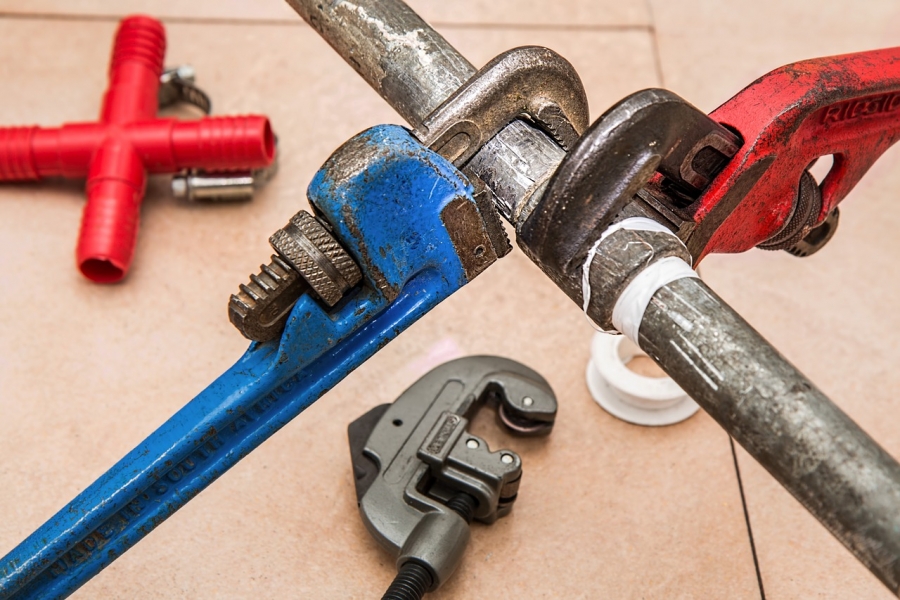“What do I need to know about the plumbing?” The answer can be rather long and rather complex, but in the simplest of terms, the plumbing of a home consists of two major parts:
• Supply System – the plumbing that brings fresh water into the home, a connection of sealed pipe sections and valves under pressure, which are intended to bring a continuous flow upon demand
• Drainage System – the plumbing that safely removes used water and waste products from within the home through a series of vented pipe sections which flow downward to allow discharge via gravity
Well, that is about as simple as the explanation gets, water in, and waste out. But there is much more to the story, such as the types of piping used, “are the pipes made of plastic, copper, or galvanized steel”?
And, “what types of connectors are used, brass fittings, soldered connectors, or adhesive materials?” And then, “what other types of fixtures or accessories are found within the system; are there well pumps, storage tanks, pressure regulators, treatment systems, water heaters, and so on?”
And, “what types of traps or clean-outs are provided for the toilets, sinks, and tub/showers”? Wow, so many things to cover, and so many locations for possible leaks. After all, plumbing systems in good service are those that deliver the inbound potable water upon demand, and then take the contaminated waste water outbound, and without any leakage along the way!
Let’s talk about the supply piping first. Prior to the early 1960’s, most homes built in the last century used inbound water pipes made of galvanized steel, galvanizing being a process of coating raw steel pipes through a corrosion resistant chemical process. Galvanizing worked well, but typically this coating material began to breakdown over time, which then left the steel piping exposed to water which in turn began the process of decay.
Usually galvanized piping had a life expectancy of approximately 40 years, maybe a bit longer depending upon their use, maintenance, or original installation methods. If the home you are purchasing has galvanized piping, it may be getting up in age and therefore this system may need to be replaced at some future point in time. Signs of corrosion or visible signs of rust detected during an inspection may suggest that the system has areas of decay, and that further evaluation may be advised.
Some other older supply systems to watch out for are various forms of flexible plastics. Only a few types of plastic piping are recommended for use within supply systems by the International Residential Code and the Uniform Plumbing Code, and these uses are very specific in nature. If you have any plastic supply piping, this should be given special attention as these are not common, and some plastic systems have been prone to have problems. Expert advice should be sought under these conditions.
Now fast forward in time just a bit. After the 1960’s construction methods began using copper piping almost exclusively. With the exception of some weaker versions of the first copper pipes (there are various grades K,L,M), extruded copper plumbing has become the gold standard. Almost all supply piping installed today in residential construction is made of copper. This type of material is largely resistant to corrosion from water, is easier to install and/or repair than steel products, and in most cases copper has become the most cost effective material overall.
The only concerns with copper piping are with respect to its softer material which is subject to puncture if struck, by a nail for example, or it may rupture if bent by accident or not supported properly. Copper piping is also subject to galvanic oxidization if connected to galvanized steel piping. Meaning that if a steel connector or section of galvanized steel pipe is attached to a copper pipe, a corrosive reaction develops slowly, usually at the point where the two sections meet.
And remember, corrosion then ultimately leads to decay and leakage. If you have copper piping, keep the entire system made of copper and all will be fine (brass fittings may also be used with copper piping as an alternative material). There are special dielectric connectors that may also be used if a steel pipe is to be connected to a copper pipe.
Okay, we are getting a bit beyond the simple explanations we promised. Just remember:
• copper = good, this is the most common material used today
• galvanized steel = fine, but regular inspection advised due to older materials
• plastic = okay, but for specific uses only in supply systems
Now before we leave the supply piping discussion we need to revisit “what does corrosion on piping really mean?” Corrosion is a process whereby external materials or very small amounts of water are making their way to the surface. Put another way, this could mean that the threads or connections where two sections of piping come together are not completely sealed tight, and therefore tiny amounts of water can get through any small gaps, thus making their way to the outside of the connection. Remember these supply water pipes are under pressure, so any weakness will give water a place to escape.
Now in this example of threaded piping, if the threads are not damaged, cleaning them with a wire brush and then adding Teflon-tape or other piping compounds to the threads might be all that is required to stop further corrosion or leakage. Repairs are not always this simple, but the point here is that corrosion is the first indication that something is not right, so any mention of corrosion on pipes/connectors or fixtures should be taken seriously as this is the plumbing systems “early warning” that repairs are needed. Left unattended, corrosion becomes a leak, and although this process may take months or weeks before a leak appears, it WILL lead to a leak at some point in time. So like most things, the sooner the problem is addressed the better!
Now let us talk about the waste or outbound drainage plumbing systems. Before the 1960s most residential applications were of clay tiles or cast iron piping (and a few less common uses of lead, brass, etc). Clay tiles didn’t last very long, only 25-40 years typically, so any clay piping still in use would be suspect to cracks and leakage. Cast iron on the other hand could last up to 80-100 years by some estimates, but also noting that there have been reports of cast piping failures as early as 40-60 years of use.
Since most of a home’s waste plumbing may be buried under a floor/slab or within the soil, it is hard to really know the true condition of the entire waste system. That being said, an inspection of the visible sections is a great placed to start, and this visual inspection can provide an indication of how the rest of the system may be functioning. Additionally, in the case of concealed areas within the soil for example, visual inspections for wet areas can also be an indication of an active leak.
Or if the water flow out from toilets/tub/showers appears to be slower than usual, this could be an indication of a break or blockages within the waste lines. If problems such as these are evident, further evaluation by a licensed plumber might be recommended, whereby these professionals could send a camera scope through the waste lines to visually inspect then from the inside out. As previously stated, the aim of any initial inspection is to detect possible warning signs, to give a general assessments, and then to recommend next steps accordingly.
If we look beyond early waste systems of clay tiles and cast iron, we move to today’s almost exclusive use of ABS plastic piping (Acrylonitrile-Butadiene-Styrene schedule 40, typically black in color). Okay, that was a mouthful, but one word to remember: “Plastics.”
Unlike supply systems, for waste systems the use of plastics has appeared to have been a huge success! ABS plastic is smooth (unlike the sand-paper texture of cast iron) so clogs due paper getting caught inside the waste lines have been drastically reduced. Plastic is also rigid, meaning that unlike clay pipes that crack if struck or squeezed by tree roots, plastic piping is more likely to withstand these external forces. And did we mention that installing or repairing ABS plastic waste lines is much easier and less costly than the other materials.
Now no discussion of waste systems would be complete without a brief mention of the many connections and fixtures used. Remember that every connecting point is an opportunity for leaks. Every toilet, sink, shower, and water-using appliance should be thoroughly checked. This starts with a visual inspection to determine if the parts were assembled properly. Then further assessments are taken to look for corrosion, stains, and leaks … these steps all begin the process of “early warning” and detection! And then of course, running water through the system can be a final measure of the waste system’s current condition.
A standard inspection process may look at literally hundreds of connection points in an average home. And in addition to determining the types of materials installed, the inspection process will try to weed-out any potential problem areas. Remember, no matter what type of system you have, the key is to keep a watch out for the signs of corrosion or leakage! Plumbing system problems can be serious and costly concerns, but the home inspection can help make the process of detection and analysis a little less of a concern.
And that completes today’s course of Plumbing 101.
Message me if your thinking about buying a Fort Collins or Loveland home at m.me/EdPowersRealEstate







